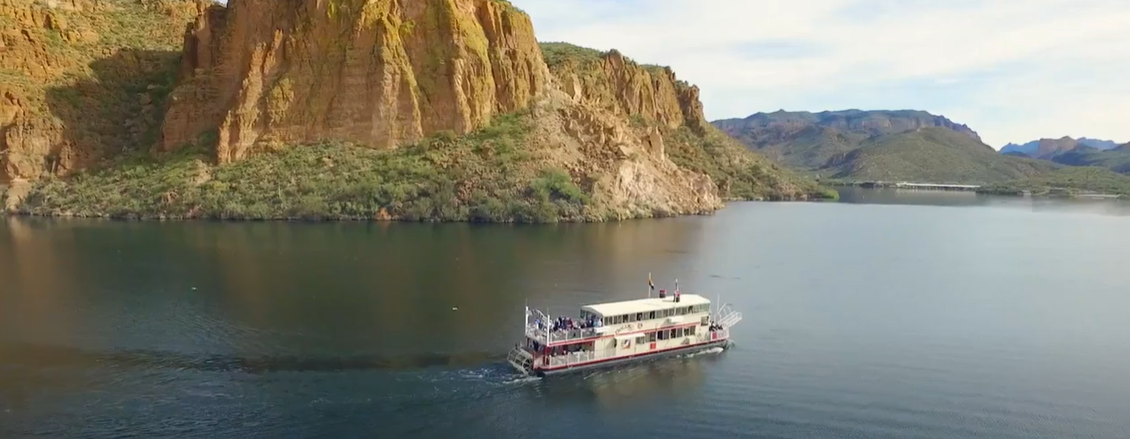The Apache Trail in Mesa, Arizona, is a scenic drive that takes visitors through rugged terrain, stunning landscapes, and rich historical sites. This 40-mile stretch of road, located in the Tonto National Forest, is a popular destination for tourists and locals alike. Driving the Apache Trail is a unique experience that combines natural beauty, cultural heritage, and adventurous spirit. Here are some of the things that make this road trip interesting:
The Apache Trail is known for its breathtaking views, which include majestic mountains, deep canyons, sparkling lakes, and ancient rock formations. The drive takes visitors through the Superstition Mountains, which rise to over 5,000 feet and are characterized by their rugged peaks, red-tinged slopes, and lush vegetation. Along the way, travelers can also enjoy the sight of Canyon Lake, a stunning reservoir surrounded by towering cliffs and crystal-clear waters, and Apache Lake, another popular destination for fishing, boating, and camping.
One of the highlights of the Apache Trail is the Theodore Roosevelt Dam, an impressive structure that was built in the early 1900s to control the flow of the Salt River and provide irrigation for the surrounding farms. The dam, which is over 280 feet high and 723 feet long, is a major engineering feat and a testament to the ingenuity and perseverance of the people who built it.
The Apache Trail is more than just a scenic drive; it’s also a journey through history. The road was originally built in the early 1900s as a supply route for the construction of the Roosevelt Dam, and it later became a popular transportation route for mining, logging, and tourism. The road’s name comes from the fact that it was used by the Apache Indians to travel between their camps and the Salt River Valley.
Throughout the Apache Trail, visitors can encounter various historical sites and landmarks that offer insight into the area’s past. For example, the Goldfield Ghost Town is a former mining town that was once home to over 4,000 people and now serves as a popular tourist attraction. The town features a museum, a saloon, a mine tour, and various shops and restaurants, all designed to evoke the atmosphere of the Old West.
Another historical site along the Apache Trail is the Lost Dutchman State Park, which is named after a legendary gold mine that was supposedly discovered by a German immigrant named Jacob Waltz. The park features hiking trails, picnic areas, and camping sites, as well as a museum that tells the story of the mine and its many tales of lost treasure, murder, and mystery.
Driving the Apache Trail is not just a scenic or historical experience; it’s also an adventure. The road is narrow, winding, and often unpaved, which makes it a challenging and exciting ride for those who love off-road driving. The trail features many hairpin turns, steep grades, and narrow bridges, as well as sections that are only accessible by 4WD vehicles.
The adventure aspect of the Apache Trail is also enhanced by the many outdoor activities that are available along the way. Visitors can go hiking, camping, fishing, boating, or birdwatching, or they can simply enjoy the sights and sounds of nature. The trail also offers opportunities for horseback riding, ATV riding, and rock climbing, as well as guided tours and scenic flights.
The Apache Trail is not just a place of natural beauty and historical significance; it’s also a cultural melting pot that reflects the diversity and creativity of the local communities. Along the trail, visitors can encounter artistic and cultural expressions that range from traditional Native American crafts to modern art installations, from cowboy poetry to musical performances.
One of the most distinctive cultural elements of the Apache Trail is the presence of Native American communities, who have lived in the area for thousands of years and still maintain their traditions and customs. The trail passes through the Salt River Pima-Maricopa Indian Community, which is home to over 9,600 tribal members and hosts various cultural events and festivals throughout the year.
Another cultural highlight of the Apache Trail is the annual Apache Leap Mining Festival, which celebrates the mining history of the area with concerts, parades, fireworks, and other festivities. The festival also features a reenactment of the legend of the Lost Dutchman Mine, as well as a mining competition and a car show.
Perhaps one of the most appealing aspects of the Apache Trail is its accessibility. The road is located just a few miles east of the Phoenix metropolitan area, which means that it’s easily accessible to millions of people. Visitors can reach the trail by car, bus, or tour, and there are plenty of parking areas, restrooms, and picnic sites along the way.
Moreover, the Apache Trail is open year-round, although some sections may be closed during certain times of the year due to weather conditions or maintenance. The trail is also relatively inexpensive to visit, with most attractions and activities priced reasonably and some even free of charge.
